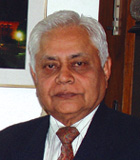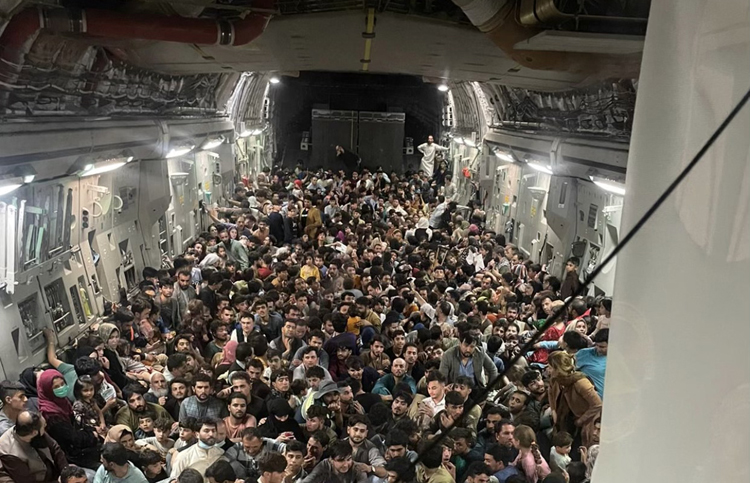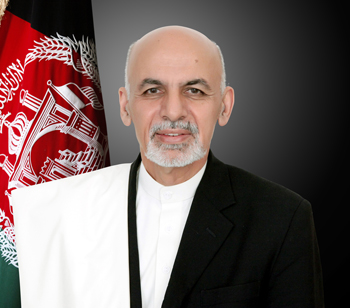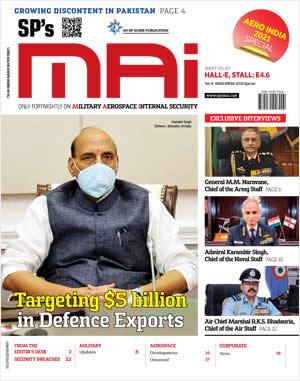INDIAN ARMED FORCES CHIEFS ON OUR RELENTLESS AND FOCUSED PUBLISHING EFFORTS

The insightful articles, inspiring narrations and analytical perspectives presented by the Editorial Team, establish an alluring connect with the reader. My compliments and best wishes to SP Guide Publications.

"Over the past 60 years, the growth of SP Guide Publications has mirrored the rising stature of Indian Navy. Its well-researched and informative magazines on Defence and Aerospace sector have served to shape an educated opinion of our military personnel, policy makers and the public alike. I wish SP's Publication team continued success, fair winds and following seas in all future endeavour!"

Since, its inception in 1964, SP Guide Publications has consistently demonstrated commitment to high-quality journalism in the aerospace and defence sectors, earning a well-deserved reputation as Asia's largest media house in this domain. I wish SP Guide Publications continued success in its pursuit of excellence.
- Operation Sindoor: Resolute yet Restrained
- India’s Operation Sindoor Sends a Clear Message to Terror and the World – ‘ZERO TOLERANCE’
- Japan and India set forth a defence cooperation consultancy framework, talks on tank and jet engines
- Terrorist Attack in Pahalgam in Kashmir: Unfolding a long surgical war against PAK
- Lt General Pratik Sharma takes over Command of Indian Army's Northern Command
Taliban Takeover of Afghanistan
Although Pakistan plays a major role in Afghanistan in practically all segments, yet Afghanistan would not like to be seen as a mere crony of Pakistan.
 |
The Author is Former Air Officer Commanding-in-Chief of Training Command, IAF |

On Sunday August 15 this year, the day on which India was celebrating the 75th anniversary of her independence from British rule, the Taliban militants took over control of Kabul, the capital of Afghanistan, after a week of rapid territorial gains from retreating government forces that had been battling to hold off the Islamist militant group.
SOVIET PRESENCE IN AFGHANISTAN
Afghanistan, a landlocked, multi-ethnic country, located in the heart of South-Central Asia, borders six countries and is dominated by the imposing Hindu Kush mountains. It has a strategic location as the nation lies along important trade routes connecting Southern and Eastern Asia to Europe and the Middle East. Afghanistan has drawn traders and invaders for millennia and has long been a prize sought by empire builders and the military of major nations have attempted to subdue it. Afghanistan has thus always been a conflict ridden nation more so in the last four decades.
In December 1979, the Soviet Union sent in more than hundred thousand troops into Afghanistan to keep the Mujahideen under check and took over total military and political control of Kabul and large parts of the country as well. Mujahideen is the plural form of Mujahid, an Arabic term that broadly refers to Islamic guerrillas who engage in jihad which is fight on behalf of Islam, Allah or the Islamic community. This action by the Soviet Union was in support of the Communist Government in Kabul that was engaged in a long drawn conflict with the anti-communist Muslim guerrillas and other insurgent groups that constituted the Mujahideen. After nearly a decade long presence in Afghanistan during which the Soviet forces lost some 15000 soldiers and as the Soviet Union was itself was on the verge of disintegration, it signed an accord with the United States (US), Pakistan and Afghanistan and opted to withdraw its forces from the country with the last soldier leaving Afghan soil on February 15, 1989.
CREATION OF TALIBAN
The word “Talib” in Pashto, the language of the Pathan community, means “Student” and its plural form is “Taliban” which means students. The origin of this name lies in the history of creation of this force. After the withdrawal of Soviet forces from Afghanistan in February 1989, the Pakistan supported Mujahideen fighters led by Gulbudddin Hekmatyar, did not make much headway as they were neither organised nor formally trained or equipped well enough to take on the forces of the then Government in Kabul led by Dr Najibullah who was pro the Soviet Union and oust him from power. Although Pakistan has always been in the denial mode, all indications are that in the early 1990s, it did initiate the process of the creation of a new force that would be well organised, trained and equipped. This new force would complement and boost the guerrilla war launched by the Mujahideen against the pro-Soviet Union Government in Kabul.
Overseen by Lt General Hamid Gul, a general in the Pakistan Army who was serving as the Chief of Inter-Services Intelligence (ISI), the premier intelligence agency, the creation of this new force called the Taliban was initiated. It is thus not without reason that Lt General Hamd Gul is branded as “Father of the Taliban”. Around 5000 young boys from the 140 odd Afghan refugee camps located in Pakistan along the border with Afghanistan who were largely of Pashtun origin and were studying is traditional Islamic schools in Pakistan called Madrasas, were recruited and trained by the Pakistan Army and appropriately named as “Taliban”. For effective leadership of this newly trained force, the Pakistan Army even deputed its officers and JCOs, both serving and retired to be a part of this organisation. With large number of Pathans available in Pakistan as refugees as also those residing in the Southern and South Eastern regions of Afghanistan who were jobless and were quite willing to join the new force, its strength soon swelled to over 40,000. The Taliban then commenced their operations and captured the city of Kandahar on November 03, 1994. With the aim of establishing their rule over all of Afghanistan, in early 1995, the Taliban began their move Northwards with the ultimate aim of taking over control of Kabul. However, this first attempt by the Taliban at capturing Kabul ended up in a failure as they suffered a devastating defeat in the battle against the forces of the Islamic State of Afghanistan operating under the command of Ahmad Shah Massoud. A year and a half later, i.e. in September 1996, as the Taliban prepared to launch a massive attack on Kabul with a larger and better equipped force, Ahmad Shah Massoud opted to pull out from Kabul and retreated into the Panjsher Valley which was the safe haven for the Tajiks. Instead of engaging with the Taliban in battles in the streets of Kabul, Massoud opted to launch anti-Taliban operations in the North Eastern Hindu Kush mountains. The Taliban ruled over Afghanistan till they were removed from power by the US-led forces in 2001. Two decades later, the Taliban are back in power in Kabul.
When viewed objectively, as India does not have land borders with Afghanistan, any military action by India in that country, is clearly not an option.
AFGHANISTAN UNDER THE RULE OF THE TALIBAN

An agreement was signed in Doha between the US and the Taliban on February 29, 2020, according to which, the majority of US troops were expected to withdraw from Afghanistan by the end of August this year, leaving the nation in the hands of the Taliban. As the forces of the Taliban closed in on Kabul, President Ashraf Ghani flew out reportedly to UAE, leaving the country in a very difficult situation. He felt that that if he had remained in Kabul, he would have been hanged in public as was done by the Taliban in its earlier tenure with ex-President Dr Najibullah. The rapidity with which the Taliban advanced Northwards and swept into Kabul with hardly any resistance from the forces of the Government or from the population of Afghanistan, is a clear indication that the Taliban are likely to be more acceptable this time round by the majority in Afghanistan. On the international scene, the list of nations that are in support of the Taliban taking over power in Kabul are Pakistan, China and Iran.
FUTURE COURSE OF ACTION BY INDIA
The uncertainty with regard to the somewhat frightening security situation in Kabul post the Taliban 2.0 coming to power and apprehensions of widespread violence, has triggered a panicky reaction leading to rapid evacuation of not only the diplomatic staff of a number of countries including India, serving in the various embassies in Kabul, but also a large number of foreign citizens working in or present in Afghanistan at that time. The major dilemma that India now faces is to identify and follow the best course of action to minimise the adverse impact on the relationship with Afghanistan in the wake of the recent developments there.
When viewed objectively, as India does not have land borders with Afghanistan, any military action by India in that country is clearly not an option. This leaves India with the options to take appropriate action limited to the political, diplomatic and economic fronts at which the current dispensation in India led by Prime Minister Narendra Modi, is quite competent. India has always had good relations with Afghanistan and there are good reasons why the new regime in Afghanistan would not like to change the status quo. In the recent years, India has invested as much as $9 billion in various infrastructure projects across Afghanistan and some of these projects are yet to be completed which should be an incentive for the new Taliban regime not to be antagonistic towards India. Besides, around 20,000 students from Afghanistan are currently studying in various universities across India. This is something that the Taliban government in Kabul would not like to disrupt. Although Pakistan plays a major role in Afghanistan in practically all segments, yet Afghanistan would not like to be seen as a mere crony of Pakistan. India therefore, needs to play her cards well, diplomatically, politically as well as on the economic front. However, India does not need to act in haste, but rather wait for the situation in Afghanistan to stabilise. Hopefully, under the new Taliban regime, Afghanistan should witness the emergence of a new dawn in not too distant a future. At this point in time it would be advisable for India to wait and watch.





